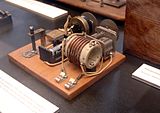Foxhole radio: Difference between revisions
ClueBot NG (talk | contribs) m Reverting possible vandalism by 110.146.165.112 to version by 81.251.154.74. False positive? Report it. Thanks, ClueBot NG. (1732424) (Bot) |
→Operation: pencils use graphite (C allotrope), not lead(Pb). |
||
| Line 13: | Line 13: | ||
==Operation== |
==Operation== |
||
The incoming radio frequency send electricity back and forth in the coil. The electricity must be fixed so that its changes will go in one direction to the earphones. The safety razor and |
The incoming radio frequency send electricity back and forth in the coil. The electricity must be fixed so that its changes will go in one direction to the earphones. The safety razor and graphite from the the pencil act like a gate. When the blade's steel and pencil's graphite come in contact with each other they will only allow electricity to go in one direction. After the electricity goes through the steel and graphite it goes into the headphones.<ref name=B&L200 /> |
||
==History== |
==History== |
||
Revision as of 00:08, 4 November 2013
A foxhole radio is a radio built by G.I.s during World War II. The foxhole radio differed from the crystal radio. A razor blade and pencil were used as a diode in a foxhole radio while a piece of crystal is used as a diode in a crystal radio.[1] The foxhole radio is like a crystal set in that it does not require an external power source. The radio is powered by the radio frequency that it receives. This made the foxhole radio ideal for the prisoner of war (POW). Prisoners of war made these radios to keep up with current events. Generally, this radio is called so because of the foxholes - small man-made underground shelters used along defensive lines during the war, and so, any radio built during the war can be regarded to be a foxhole radio, but ideally, this radio does NOT use semiconductors and does not have access to a power supply. In 1942 Lieutenant Colonel R. G. Wells was a prisoner of war in Japan. Wells built a foxhole radio because he lacked information about the international situation. The whole POW camp had a genuine craving for news by whatever means according to Wells.[2]
Designs
Foxhole radios were built using numerous designs. Most of them used a razor blade which had a wire running from each blade between the headphone terminals and antenna with a pencil lead sitting on the blade. Most of these wartime sets did not have a slider/tuner arm. Without the tuner they could only tune into one frequency. Richard Lucas, a POW in Vietnam, constructed a radio in camp and built his own earphones. Richard built his earphones by binding four nails together with cloth then winding wire and dripping wax over the turns. After about ten layers of wire he placed it in a piece of bamboo. A tin can lid was placed over the coil of wire. The listener connected the improvised earphone to the foxhole radio and received three radio stations. Best listening was at night, according to Lucas.[3]
Operation
The incoming radio frequency send electricity back and forth in the coil. The electricity must be fixed so that its changes will go in one direction to the earphones. The safety razor and graphite from the the pencil act like a gate. When the blade's steel and pencil's graphite come in contact with each other they will only allow electricity to go in one direction. After the electricity goes through the steel and graphite it goes into the headphones.[1]
History
During World War II, Toivo Kujanpaa stationed at Anzio Beachhead used a Foxhole radio to receive German propaganda programs. The propaganda programs were directed towards American military from an Axis station in Rome.[4] American G.I.'s in Italy would put several radios together. The G.I.s would listen at night near the front lines to phonograph records played on a radio station in Rome. You could usually hear a radio station on a foxhole radio if you lived twenty five or thirty miles away.[1]
References
- ^ a b c Gould Jack, 1958 "How to build a foxhole radio." All about Radio and Television. Random House. Pages 58-72.
- ^ R G Wells: The need for a radio., Oral History Research Unit at Bournemouth University, retrieved 2011-10-19
- ^ foxehole, bizarrelabs.com, retrieved 2011-10-19
- ^ Make a crystal radio, wikihow.com, retrieved 2011-10-21




